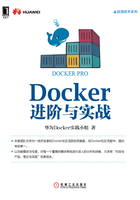
上QQ阅读APP看书,第一时间看更新
1.3.2 Docker的使用
对于Docker的使用,可以花整本书来介绍其中的各种细节、使用技巧和实战经验等,本节更希望告诉读者学习使用的方法,而对于使用技巧和实战经验会在本书的其他部分贯穿说明。
对于初学者,官方提供的[tryit](https://www.docker.com/tryit/)是最好的快速入门途径,建议每一个初次接触Docker的用户都可以试一试。对于有一定经验的用户,在使用中遇到问题或者不确定具体的用法时,可以通过以下途径来查看帮助信息。
1)在控制台直接运行docker,这样会列出Docker支持的所有命令和一些通用的参数,如下:
$ docker
Usage: docker [OPTIONS] COMMAND [arg...]
docker daemon [ --help | ... ]
docker [ -h | --help | -v | --version ]
A self-sufficient runtime for containers.
Options:
--config=~/.docker Location of client config files
-D, --debug=false Enable debug mode
-H, --host=[] Daemon socket(s) to connect to
-h, --help=false Print usage
-l, --log-level=info Set the logging level
--tls=false Use TLS; implied by --tlsverify
--tlscacert=~/.docker/ca.pem Trust certs signed only by this CA
--tlscert=~/.docker/cert.pem Path to TLS certificate file
--tlskey=~/.docker/key.pem Path to TLS key file
--tlsverify=false Use TLS and verify the remote
-v, --version=false Print version information and quit
Commands:
attach Attach to a running container
build Build an image from a Dockerfile
commit Create a new image from a container's changes
cp Copy files/folders from a container to a HOSTDIR or to STDOUT
create Create a new container
diff Inspect changes on a container's filesystem
events Get real time events from the server
exec Run a command in a running container
export Export a container's filesystem as a tar archive
history Show the history of an image
images List images
import Import the contents from a tarball to create a filesystem image
info Display system-wide information
inspect Return low-level information on a container or image
kill Kill a running container
load Load an image from a tar archive or STDIN
login Register or log in to a Docker registry
logout Log out from a Docker registry
logs Fetch the logs of a container
pause Pause all processes within a container
port List port mappings or a specific mapping for the CONTAINER
ps List containers
pull Pull an image or a repository from a registry
push Push an image or a repository to a registry
rename Rename a container
restart Restart a running container
rm Remove one or more containers
rmi Remove one or more images
run Run a command in a new container
save Save an image(s) to a tar archive
search Search the Docker Hub for images
start Start one or more stopped containers
stats Display a live stream of container(s) resource usage statistics
stop Stop a running container
tag Tag an image into a repository
top Display the running processes of a container
unpause Unpause all processes within a container
version Show the Docker version information
wait Block until a container stops, then print its exit code
Run 'docker COMMAND --help' for more information on a command.
2)在控制台执行“docker+命令+--help”,比如“docker start--help”,这样会列出docker start命令支持的所有参数,如下:
$ docker start -–help
Usage: docker start [OPTIONS] CONTAINER [CONTAINER...]
Start one or more stopped containers
-a, --attach=false Attach STDOUT/STDERR and forward signals
--help=false Print usage
-i, --interactive=false Attach container's STDIN
3)使用man命令查看帮助文档。对于通过rpm包等方式安装的Docker,一般都会默认安装对应的man文档,此时可通过“man+docker+command”的方式查看子命令的帮助文档,比如“man docker start”,通常man手册中包含的帮助信息会更丰富一些,通过完整地阅读man手册,基本上就可以掌握该命令的常规用法。
DOCKER(1) JUNE 2014 DOCKER(1)
NAME
docker-start - Start one or more stopped containers
SYNOPSIS
docker start [-a|--attach[=false]] [--help] [-i|--interactive[=false]] CONTAINER [CONTAINER...]
DESCRIPTION
Start one or more stopped containers.
OPTIONS
-a, --attach=true|false
Attach container's STDOUT and STDERR and forward all signals to the process. The default is false.
--help
Print usage statement
-i, --interactive=true|false
Attach container's STDIN. The default is false.
See also
docker-stop(1) to stop a running container.
HISTORY
April 2014, Originally compiled by William Henry (whenry at redhat dot com) based on docker.com source material and internal work.
June 2014, updated by Sven Dowideit (SvenDowideit@home.org.au)